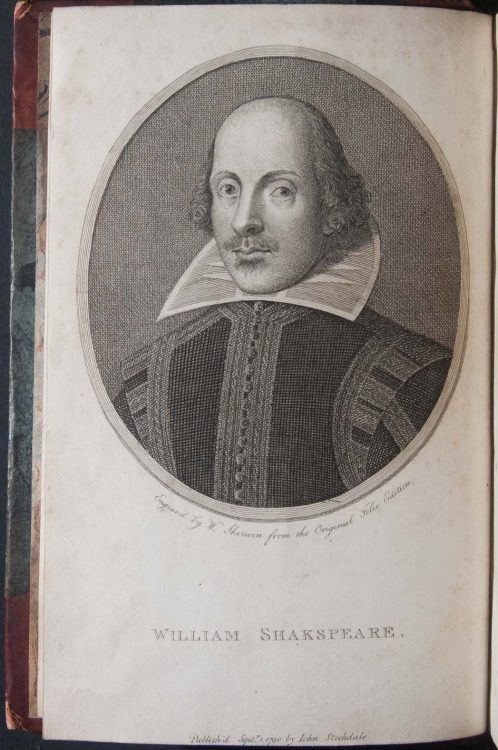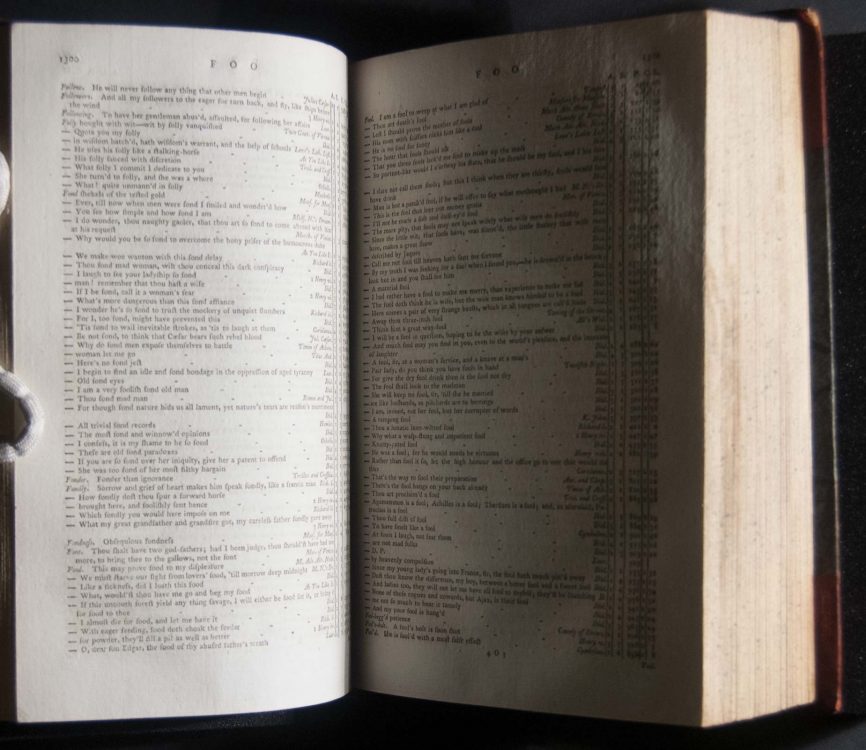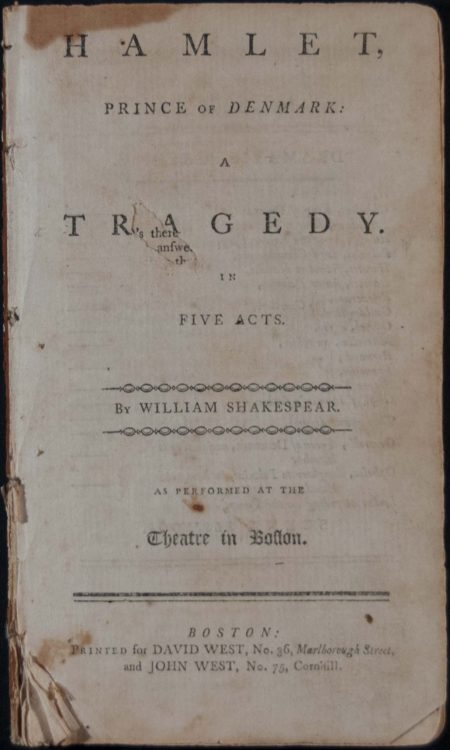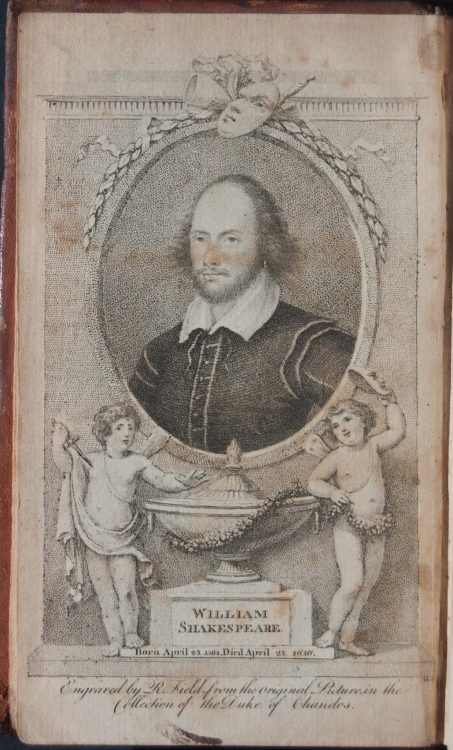William Shakespeare
Twenty of the Plays of Shakespeare, Being the Whole Number Printed in Quarto During His Life-Time, or Before the Restoration, Collated Where There Were Different Copies, and Publish’d From the Originals. London: Printed for J. and R. Tonson, in the Strand; T. Payne, at the Mews-gate, Castle-Street; and W. Richardson, in Fleet-Street, 1766.
Appearing 150 years after the playwright’s death, the George Steevens edition of Shakespeare presents an early example of Shakespearean textual scholarship. Whereas most printed editions of Shakespeare’s works reprinted the texts as they had appeared in the First through Fourth Folios, the English Shakespeare scholar George Steevens (1736-1800) produced his edition by examining as many quarto editions as he could find. Steevens concluded that the quartos were particularly valuable - more so than the folios - for having been produced during Shakespeare’s lifetime. He speculated (without evidence) that many of the quartos had been published with Shakespeare’s own oversight, thus lending them an authorial legitimacy that the posthumously published Folios lacked. In places where the First Folio contained longer versions of the plays, Steevens speculated (also without evidence) that the editors of the First Folio had introduced their own expansions on what Shakespeare had actually written.
Throughout the edition, Steevens also presented the many textual variations that appear in the different quartos, making this one of the first attempts to collate the different versions of the plays; for example, the edition of Hamlet that is presented in this volume was based primarily on the text of the 1611 quarto (now known as the third quarto of Hamlet). He then collated this text against three other versions, now known as thesecond (1605), fourth (circa 1622), and fifth (1637) quartos of Hamlet. (A first quarto, from 1603, also exists, although Steevens did not have access to it.) The copy on display is opened to Hamlet’s “to be or not to be” speech, for which Steevens has presented two variant readings.
William Shakespeare
Shakspeare's Dramatic Works; With Explanatory Notes. A New Edition. To Which Is Now Added, a Copious Index to the Remarkable Passages and Words. London: Printed for John Stockdale, 1790.
In 1784, John Stockdale (ca. 1749-1810), a publisher and former blacksmith, published the first single volume collection of Shakespeare’s plays since the printing of the 1685 Fourth Folio. At the time, most editions of Shakespeare were appearing in large (and expensive) sets of six to ten volumes. In his introduction, Stockdale stated that his goal in printing a single-volume Shakespeare was to make his works more readily available in a more economically friendly format. The second edition of Stockdale’s Shakespeare, shown here, appeared with the plays split between two volumes, a concession to the many readers who had complained that Stockdale’s 1079-page, one-volume edition was too large to be practical.
Stockdale’s introduction presented Shakespeare as a playwright whose works should serve as a source of both entertainment and instruction. Shakespeare, according to Stockdale, had such insight into human nature and the human condition that just by reading him one could gain a better understanding of one’s own self.
For this edition, Stockdale commissioned an engraved illustration of Shakespeare based off of the famous Droeshout engraving that had appeared in the First through Fourth Folios. The engraving is signed by W. Sherman.
Samuel Ayscough (1745-1804)
An Index to the Remarkable Passages and Words Made Use of by Shakespeare; Calculated to Point Out the Different Meanings to Which the Words are Applied. London: Printed for John Stockdale, 1790.
For his second printing of Shakespeare, Stockdale introduced a third volume containing a new index to Shakespeare’s plays, which cataloged all of the different ways in which Shakespeare had used particular words in his writings. This index, assembled by Samuel Ayscough, an English librarian and antiquary, was the first such concordance produced for Shakespeare’s works. In his introduction, Stockdale noted that one of the benefits of his concordance was that it would help to preserve a sense of the ways in which words were used in Shakespeare’s time, as the vocabulary and usage of the English language had already changed a great deal in the 174 years since Shakespeare’s death.
William Shakespeare
Hamlet, Prince of Denmark: A Tragedy. In Five Acts. Boston: Printed for David West, No. 36, Marlborough Street, and John West, No. 75, Cornhill, 1794.
This edition of Hamlet is one of the first two Shakespeare texts printed in the United States. (The other was an edition of Twelfth Night also printed in 1794 for David and John West.) It presents an abridged version of the play that had been performed at the Boston Theatre, probably based off a performance text assembled by John Bell in England in 1773. Although Shakespeare had been performed in America since at least 1730, he was a recent latecomer to Boston, where anti-theatrical sentiments were strong among much of the city’s citizenry. (In 1750, an act of the General Court of Massachusetts had actually banned all “Stage-plays and other theatrical entertainments.”) In 1792, Boston’s first theatrical performances had appeared in what was called the “new exhibition room.” Romeo and Juliet and Hamlet were among its first productions, where they were presented not as theater, but as “moral lectures.” The Boston Theatre (also known as the Federal Street Theater) opened on February 3, 1794, with Shakespeare’s plays featuring among its early performances.
William Shakespeare.
The Plays and Poems of William Shakspeare: Corrected from the Latest and Best London Editions, with Notes by Samuel Johnson, L.L.D. Philadelphia: Printed and sold by Bioren & Madan, 1795.
English colonists had introduced William Shakespeare’s works to the Americas by at least 1699, with printed editions of Shakespeare becoming increasingly common in the colonies over the course of the eighteenth century. However, all such copies of Shakespeare had been available only as imports from overseas. The practical logistics and hardships of life in the New World meant that printing developed slowly in the colonies. In places where printing did exist, it was usually limited to religious texts, practical and legal documents, almanacs, and newspapers. The Bioren & Madan edition of Shakespeare, shown here, was the first edition of Shakespeare’s collected works to be published in the United States, as well as the first such edition to be published outside of England and Ireland. The text was derived from a Dublin reprint of Asycough’s edition, although Bioren & Madan opted to modernize the spelling of Shakespeare’s words.
In the introduction to this printing, the editors spent a great deal of time arguing against the perceived immorality of Shakespeare’s plays. In Shakespeare’s defense, they maintained that, unlike with the works of lesser playwrights, Shakespeare’s characters “are never expressly drawn to recommend vice,” and, all in all, the plots of his plays are designed to encourage moral behavior. The editors also complained that the English editions had grown overburdened with excessive notes and commentary. (They singled out, by way of example, one line from Othello in a recent edition that was “clogged with ten successive explanations.”) By contrast, the Bioren & Madan edition was supplied with only a glossary of archaic words and brief concluding commentaries by Samuel Johnson. The editors claimed that this reflected a uniquely American approach to literature, stating that “an American reader is seldom disposed to wander through the wilderness of verbal criticism. An immense tract of excellent land, uncultivated, and even unexplored, presents an object more interesting to every mind than those ingenious literary trifles, that in Europe command so much attention.”






